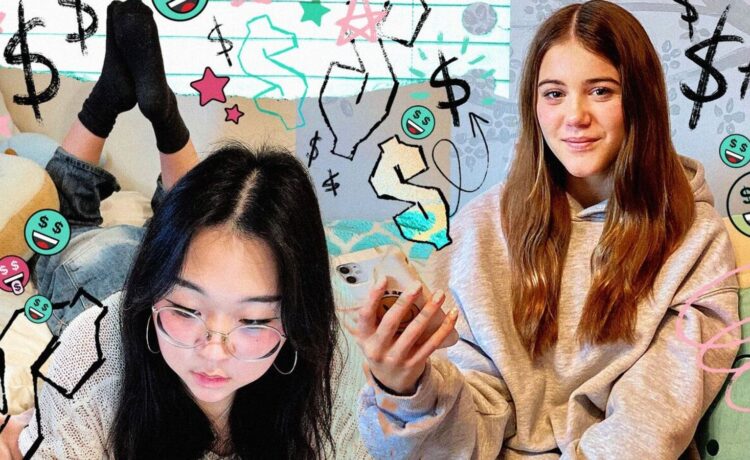Sophia, a high school junior in the Chicago suburbs, invests in stocks such as Tesla, Apple and Amazon.com. When she started making money as a social-media content creator three years ago, her parents encouraged her to put some of her earnings in investments likely to grow over time, rather than parking all her cash in a savings account.
She now has several thousand dollars invested in accounts set up by her father at Charles Schwab, Edward Jones and Robinhood. Last year, she saved up money to buy a new Tesla Model 3, which starts at around $40,000, through a payment plan she is splitting with her parents. On TikTok, Instagram and YouTube, she makes videos teaching her thousands of followers about investing basics.
“I’ve always had a business mindset of wanting to make money, and I’m very OK with taking risk,” Sophia said. “There’s really no minimum age to start.”
Sophia is one of many teenagers jumping into the U.S. stock market. Teens generally can’t open their own brokerage accounts until they turn 18, but adults can set up custodial accounts for minors. The accounts are turned over to the children when they reach legal age.
Custodial accounts for teens at Schwab totaled nearly 200,000 in 2022, up from about 120,000 in 2019, according to the company. They jumped above 300,000 in 2023, thanks in part to Schwab’s integration of TD Ameritrade. Other brokerages, including Vanguard, Fidelity and Morgan Stanley’s E*Trade, also reported a surge in custodial accounts in recent years.
Some teens ask their parents to open accounts—and share the login information—at brokerages such as Robinhood that don’t offer custodial accounts. At smaller financial apps such as Greenlight, teenagers are investing more money than ever before. They invested $20 million in 2023 using the Greenlight app, up from around $10 million in 2021.
A Fidelity study on teens and money recently estimated that about a quarter of teenagers in the U.S. have started investing, based on an online survey of 2,081 respondents ages 13 to 17. Trades placed using Fidelity’s Youth app, an account opened by parents but owned by teens, jumped in the fourth quarter.
Many teenagers opened up their accounts during winter break while off from school, said Kelly Lannan, a senior vice president at Fidelity.
The boom in teen trading is part of a wider rush to financial markets among Americans since the start of the Covid-19 pandemic. Stocks rocketed higher, drawing hordes of newbie investors trying to profit from the big gains.
Many of those new investors have since ditched the meme stocks that soared during that era but have remained invested, sending the share of Americans who own stocks to an all-time high.
Stocks are back at record levels, with the Dow Jones Industrial Average recently topping 38000 and the S&P 500 eclipsing 5000 for the first time. Since the start of 2020, when an unprecedented trading boom among rookie investors kicked off, the S&P 500 has soared around 55%.
“There’s just more and more awareness that the sooner you start, the better things are,” said James Martielli, head of investment and trading services at Vanguard.
Martielli said he opened custodial accounts for his three children more than a decade ago when they were toddlers. At Vanguard, there has been a jump in custodial IRAs, a type of retirement account.
The biggest advantage is time. Setting aside $10 a week for a child at birth would leave an 18-year-old with a roughly $20,000 nest egg, assuming an 8% annual return, according to the investing app Stash, which offers custodial accounts. Left until the investor turned 70, and assuming annual growth of 8%, that sum would mushroom to about $1 million.
Of course, these returns can be shaped by many factors, including when an investor buys in and how stocks end up doing. The S&P 500 has recorded a 10% annualized total return over the past three decades, according to Dow Jones Market Data through the end of 2023. Buying an S&P 500 index fund at the peak of the dot-com bubble in 2000 would generate an annualized total return of around 7%, while buying at the low of the financial crisis in 2009 would lead to a roughly 16% annualized total return.
Hot tech stocks
Brokerage executives say that technology behemoths that are ubiquitous in the lives of teens are often some of the most widely held shares. At Vanguard, U.S. stock index funds are particularly popular in custodial accounts.
Mahanth Komuravelli, 16, has a small chunk of his roughly $7,000 portfolio in an S&P 500 index fund, while most of his positions are in big companies such as Amazon and Advanced Micro Devices. He is exploring buying some small-cap stocks such as education company Chegg. Mahanth uses a Fidelity Youth Account that his father helped him open. The two often discuss investment ideas.
“Sometimes he asks me for advice,” said Mahanth, a high school junior in Edison, N.J.
Kaida Benes, a 13-year-old from the suburbs of Minneapolis, has been stashing money—earned from household chores such as doing the dishes or cleaning the bathroom—in an investment account on Greenlight that now has about $1,000 in it.
She’s also been drawn to bigger companies and has invested in tech stocks such as Apple, Alphabet and streaming companies Disney and Netflix. At times, she has been on edge about potential losses. She says her mother has helped her stomach the volatility.
“Stocks go up and down. It’s fine, it just happens,” Kaida said she’s learned.
She has been hunting for other opportunities to make money to pour into savings or investments. She recently found a recliner chair at a yard sale and enlisted her parents to help fix it up and flip it for a profit on Facebook marketplace, she and her mother, Renee Benes, said.
“I like having money,” Kaida said.
Renee Benes said she was frustrated that she didn’t learn about investing until a year or two ago, when she was well into her 30s. Benes, who’s an online influencer, wanted her daughter and son to be more financially savvy.
Lessons learned
Many young investors are starting to invest earlier than previous generations did. Almost two-thirds of Gen Z investors said they first started learning about investing in high school or middle school, compared with about 38% of millennials in a 2023 Bank of America survey of affluent individuals. Some are introduced to stocks through family members or teachers, while others have turned to social media.
Felix Peng, a 17-year-old in the Los Angeles area, said he has learned a lot about investing from YouTube and Instagram—but that some social-media stars promote riskier trading strategies that seem more like gambling. He said it is a red flag when influencers try to sell expensive trading courses that promise investors they will make a lot of money quickly.
Still, Felix believes it is beneficial for young people to learn from their mistakes when they have less money to lose. His investments in Apple, Meta Platforms and Alphabet have performed well. But when he bought shares of Teladoc around their peak and watched them tumble, he saw how tough it is to time the market. He has about $1,000 in a custodial account on Stockpile, an investing app geared toward parents and children.
“It’s a great lesson and I’m glad I learned,” Felix said.
Seventeen-year-old Rachael Kim in Orange County, Calif., traded shares of AMC Entertainment Holdings during the meme-stock era and said she made a roughly 300% profit.
“For a little while, I got addicted to that adrenaline,” Rachael said of day trading. “But as I began researching more, I realized it was highly unlikely to continue that aggressive profit.”
Rachael said she started studying investing to help her parents, who are immigrants, prepare for retirement. Now she regularly invests about half of the money she makes—from creating social-media content, working as a cashier and teaching at her church—in index funds tracking the S&P 500 and tech-heavy Nasdaq-100. She has about $10,000 in her custodial Roth IRA at Fidelity.
“Since we’re young, we have the privilege of seeing our investment compound,” Rachael said. “The biggest lesson would be to start early.”
Write to Hannah Miao at [email protected] and Gunjan Banerji at [email protected]
















